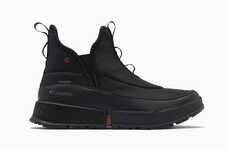Nicholas Bennett's Waterproof Suit is a Response to Climate Change
Kalina N — January 16, 2020 — Art & Design
This "flood-proof commuter suit" is foreseeing the possible reality as climate change progresses and the consequences on our planet become exponentially more visible. This piece is designed by Glodsmiths student Nicholas Bennett who considered the rising sea-levels as a main component in the silhouette.
The waterproof commuter suit is intended to help individuals in the future cope with the possibility of frequent floods. For this project, Nicholas Bennett has merged "office-appropriate brogues" with wellies and waders in fluorescent orange. The model is flexible as wearers can adjust the length. Laces are present at the side to reduce the bulkiness of the piece.
The flood-proof commuter suit might be odd to some, however, this might as well be a necessary product in the future. The design is debuted through a short film that illuminates its functionality.
Image Credit: Dezeen
The waterproof commuter suit is intended to help individuals in the future cope with the possibility of frequent floods. For this project, Nicholas Bennett has merged "office-appropriate brogues" with wellies and waders in fluorescent orange. The model is flexible as wearers can adjust the length. Laces are present at the side to reduce the bulkiness of the piece.
The flood-proof commuter suit might be odd to some, however, this might as well be a necessary product in the future. The design is debuted through a short film that illuminates its functionality.
Image Credit: Dezeen
Trend Themes
1. Climate-adaptive Clothing - Designing clothing and accessories that help individuals adapt to the effects of climate change, such as flooding and extreme weather conditions.
2. Hybrid Workwear - Combining traditional workplace clothing with functional and practical elements to meet changing climate needs.
3. Sustainable Materials Innovation - Finding new, eco-friendly materials to construct clothing that is both stylish and functional in a changing environment.
Industry Implications
1. Fashion - There is an opportunity for the fashion industry to innovate and create climate-adaptive clothing that is both fashionable and practical.
2. Outdoor Gear - Innovation in outdoor gear such as waterproof and breathable materials could be beneficial for both extreme outdoor activities and commuting in flood-prone areas.
3. Environmental Design - Designing infrastructure and buildings for future climate change could include incorporating climate-adaptive clothing and gear into office spaces, transportation systems, and emergency response plans.
2.5
Score
Popularity
Activity
Freshness














